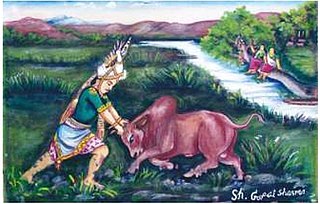
Moirang is a town in the Indian state of Manipur, best known for the tentatively listed UNESCO World Heritage Sites of the Keibul Lamjao Conservation Area (KLCA), covering Keibul Lamjao National Park (KLNP), the world's only floating national park, the buffer of Loktak Lake and Pumlen Pat. It is best known for the being the place of origin of the ancient epic legend of Khamba and Thoibi, one of the seven epic cycles of incarnations of Meitei mythology and folklore. Nationwide, it is also famous for the INA War Museum in the INA Martyrs' Memorial Complex, where Colonel Shaukat Malik of the Indian National Army hoisted the Tricolour for the first time on Indian soil on 14 April 1944. It is situated approximately 45 km (28 mi) south of the state capital Imphal. It has an area of 269 km2 (104 sq mi) with a population of 62,187 in 67 villages. There are 12 Panchayats in this block.

Lai Haraoba is a traditional Meitei religious festival of ritual dance and musical theatre, celebrated annually in honour of Umang Lais, the forest deities of Sanamahism.

Meitei literature, also known as Manipuri literature, is literature written in the Meitei language of Manipur. An ancient institution of learning, the Luwang Nonghumsang, later known as the Pandit Loishang, collected sources of indigenous Meitei knowledge and philosophy until the 18th century. Writing by Meiteis is assumed to go back to the Kingdom of Kangleipak in the early 12th century. The Meitei script is a Brahmic abugida. It is known only from the Puya manuscripts discovered in the first half of the 20th century. Manuscripts of the 18th and 19th centuries were written using the Bengali alphabet. The existence of the Meitei script in the 15th-century hinges on the authenticity of an inscription dated to the reign of Senbi Kiyamba. The first printed Manipuri book, Manipurer Itihas, appeared in 1890 from the Baptist Mission Press, Calcutta. Though the kings of Manipur had established contact with the British from the middle of the eighteenth century onward the real impact of the contact came much later. Johnstone Middle English School, based on the western system of education, was started in 1885 at Imphal, and in 1891 Manipur lost its independence to the British. British domination facilitated the introduction of new systems in the civil, political and educational spheres, which hastened the process of modernization in Manipur, exposed as it was to new ideas and influences.

Indira Gandhi Rashtriya Manav Sangrahalaya also referred to as the National Museum of Humankind, or Museum of Man and Culture is a museum located in Bhopal, Madhya Pradesh, India. The museum spreads over an area of about 200 acres on the Shymala Hills in the city. This museum depicts the story of mankind in time and space. It is the largest ethnographic museum in India.

The Loktak Folklore Museum or the Thanga Folklore Museum is a folk museum in Thanga Island in the Loktak lake of Manipur, India. It cares for and displays a collection of artistic, cultural and historical artefacts associated with the Loktak lake. The museum preserves the folk customs and beliefs, folk medicines, folk literature associated with the Loktak lake.

Dragons play a significant role in the legendary accounts of Meitei folklore, Meitei literature, Meitei mythology and Meitei religion (Sanamahism) of Ancient Kangleipak, Medieval Kangleipak and Modern Kangleipak.

Thangching or Thangjing is a primordial deity in Sanamahism, the indigenous religion of Manipur. He is the ruling deity of the Moirang dynasty. He rules supreme on the banks of the landlocked sea, Loktak lake. He is one of the four cardinal Umang Lais. The guardianship of the south western direction is alluded to Thangjing and the other directions to Koubru, Marjing and Wangbren.

Kao is a legendary divine bull captured by Khuman Khamba in Meitei mythology and folklore of ancient Moirang realm. It appears in the legend of Kao Phaba, also known as Khambana Kao Phaba of the Khamba Thoibi epic.

The Khambana Kao Phaba is a 2001 oil canvas painting by Manipuri artists, M Betombi Singh and Gopal Sharma. The painting shows the capture of powerful Kao bull by hero Khamba. It is one of the most well known museum series "Exhibit of the Month" of the Indira Gandhi Rashtriya Manav Sangrahalaya in India. It was exhibited for a whole month of July, 2019.

The Kangla Sanathong, also known as the Kangla Gate, is the western entrance gate to the Kangla Fort in Imphal West district of Kangleipak.

The ancient legend of Khuyol Haoba and Yaithing Konu is one of the epic cycles of incarnations of Meitei mythology and folklore, that is originated from Moirang kingdom of Ancient Kangleipak. It concerns the fateful love of Khuyol Haoba, an orphan man, for the beautiful Yaithing Konu. Khuyol Haoba was the son of late Khundouremba, a court official of Moirang. Yaithing Konu was the daughter of Luwang Huiningsumba, an influential nobleman of Moirang.

The ancient legend of Ura Naha Khongjomba and Pidonnu is an epic cycle of incarnations of Meitei mythology and folklore from the Moirang kingdom of Ancient Kangleipak. It concerns the love and adventures of the forgotten prince Ura Naha Khongjomba for the beautiful woman Pidonnu.

The ancient legend of Khamba and Thoibi is a classic, as well as one of the epic cycles of incarnations of Meitei mythology and folklore, that is originated from Ancient Moirang kingdom of Ancient Kangleipak . It is referred to as the "National Romantic Legend of Manipur" by Padma Vibhushan awardee Indian scholar Suniti Kumar Chatterjee.

A Maiba or an Amaiba (literally, "priest") is a male religious leader authorised to perform the sacred rites and rituals of Sanamahism (Meitei religion), especially as a mediatory agent between human beings and one or more deities. They have the authority or power to administer religious rites as well as sacrifices to gods. Their office or institution is called Maiba Loishang (Maiba Loisang), later renamed as Pandit Loisang, during Aryanisation of Meitei culture. They also served as healers, doctors, magicians, medicine men, physicians and shamans. They play important roles in the ancestor worship (apokpa khurumjaba) ceremony. Chief priest or chief among the maibas is called Maichou, a term formed with the amalgamation of two words ("maiba"- priest, "achouba"- big, chief, great). Since their position is not hereditary, they acquire their positions through talent and skills. The female counterpart of a Maiba is a Maibi.
In Meitei mythology and folklore, Kabui Salang Maiba may refer to:

Loktak Ima, also known as Loktak Lairembi, is the personification of the Loktak lake, who is revered by the Meitei people as the mother goddess of the sacred waters of the Loktak lake. She is highly respected and venerated by the fishermen communities of the Meitei ethnicity living in and around the periphery of the Loktak lake. She is also considered as the fountainhead of Meitei culture. Her embodiment, the Loktak lake is associated with the epic of Khamba and Thoibi as well as that of Poubi Lai of Meitei mythology and folklore.

Animals have significant roles in different elements of Meitei culture, including but not limited to Meitei cuisine, Meitei dances, Meitei festivals, Meitei folklore, Meitei folktales, Meitei literature, Meitei mythology, Meitei religion, etc.

Kumcha Lempi, also known as Kumja Lembi, is a woman in Meitei mythology and folklore of ancient Kangleipak. She is known for being a victim of an attack by a tiger in Khoirentak. Her tragedy is frequently mentioned, narrated and retold in the Moirang Kangleirol legends, usually by the Pena playing balladeers till present times.

The intangible cultural heritage (ICH) of Meitei civilization is recognised, honoured, preserved as well as promoted by the UNESCO, the Ministry of Culture of the Union Government of India, the Government of Armenia, the State Government of Manipur, the State Government of Assam, the State Government of Tripura, among many other notable institutions.

















